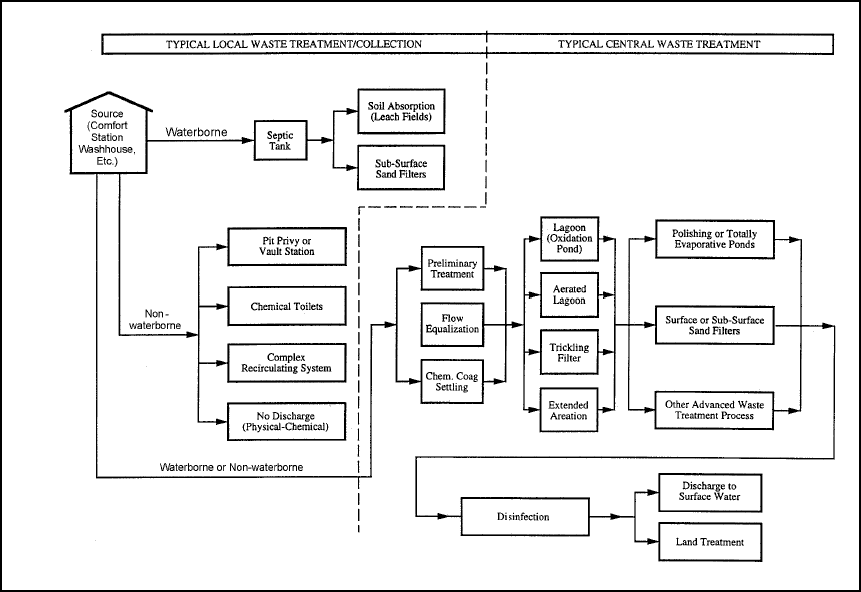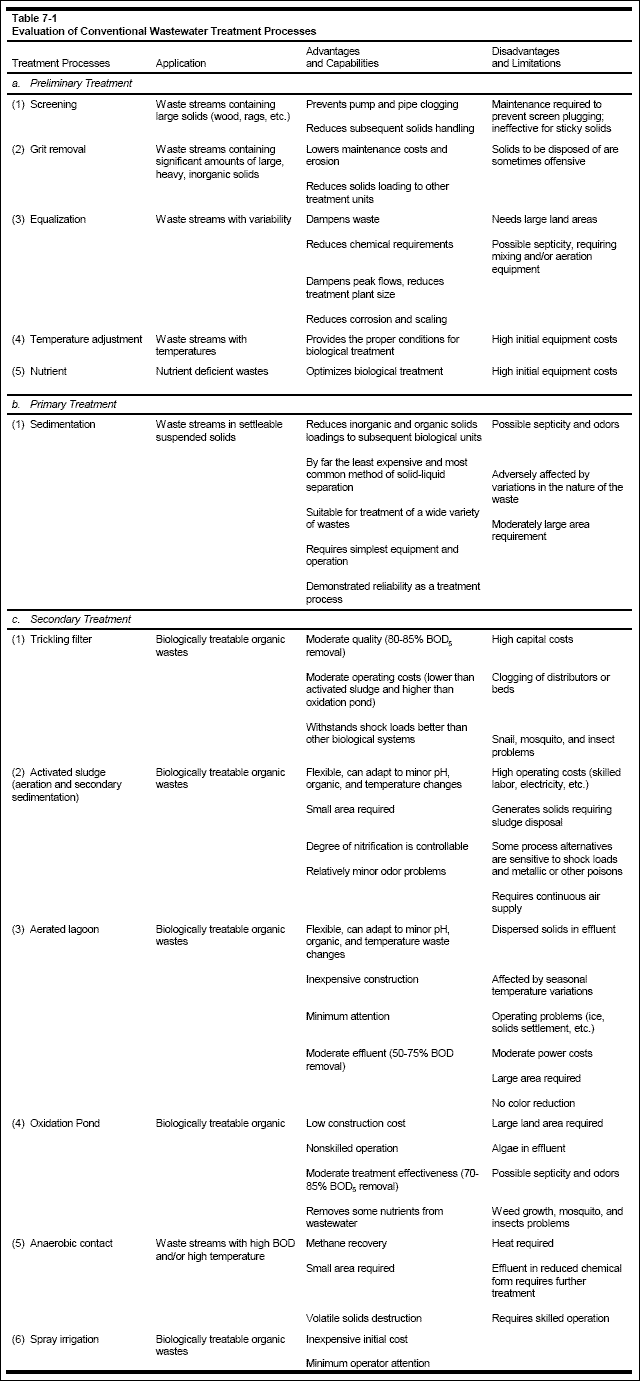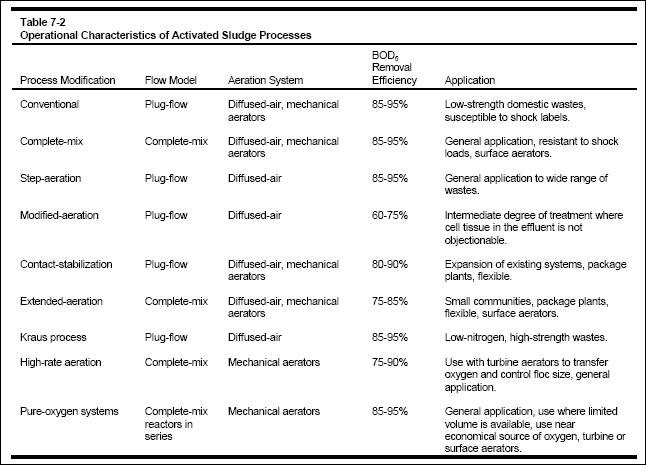Design, Construction, and Operation of the Small Wastewater Systems - 07...
Chapter 07 - Treatment Process Selection...
7-1. Overview...
It is very important that safe and effective disposal of human and domestic wastes be provided in recreational areas to
ensure the preservation of the quality of surface water and groundwater. The selection of appropriate wastewater treatment
facilities for recreational areas should be based on site visitation, design considerations, local resources, economics,
health factors, aesthetics, safety, and access. A discussion of these parameters and how they affect the selection of the
treatment process is presented in this chapter. Figure 7-1 presents the typical wastewater treatment and disposal
alternatives available for treating waste produced at USACE recreational areas, and compares of the advantages/capabilities
and disadvantages/limitations of these processes.
7-2. Site Visitation...
For recreational facilities with less than 30,000 visits each year, the design engineer may consider selecting a wastewater
collection system that does not involve water-carried waste. These would be single-unit installations such as comfort
stations and facilities in remote areas. Generally, soil, climate, and availability of water and power will dictate the
selection for this type of facility.
7-3. Local Resources...
( a ) Resource-limited sites.
Certain sites may be resource limited and may require specialized systems. For example, a comfort station having minimal
quantities of water may require a plan using a combination of water for hand washing and a non-potable water source unit
for urinals and water closets. Such a design would allow for the segregation of graywaters and blackwaters and possibly
simplify the overall system design. Gray wastewater may, in some instances, be treated onsite by septic tanks and absorption
fields. In other instances, it may be necessary to include additional facilities for pumping and trucking wastewater to a
central facility for further processing.
( b ) Other sites.
Other sites may not be resource limited and, when the annual visitation is small, may allow a total on-site treatment of
wastewater through utilization of the appropriate processes.
7-4. Economic Considerations...
Economic considerations must be site-specific and based upon alternatives available for a particular site.
( a ) Ranking of treatment alternatives.
Computer-assisted techniques can be used to rank different wastewater treatment alternatives, each capable of meeting
specified effluent criteria, on the basis of cost effectiveness. Two currently available computer programs which can aid
the design engineer in the design and selection of recreational treatment facilities are described below. Both programs
rank different alternatives based on overall cost estimates including capital costs and operation and maintenance (O&M)
costs.
( b ) Capital costs.
Capital costs are those associated with the purchase of land, equipment, plant construction, and other related facilities.
The most accurate capital cost can be estimated by obtaining price quotes from local equipment suppliers and contractors.
If time and budgetary constraints prohibit the design engineer from obtaining actual quotes, the capital cost of any size
treatment system may be estimated based on past costs. Because costs continually change, it is important that the capital
costs of any treatment altenative are referenced to the same cost indices. The Environmental Protection Agency (EPA)
periodically publishes wastewater treatment plant and sanitary sewer cost indices. One of the most commonly used cost
ndices is the Engineering News-Record Construction Cost (ENRCC) Index.

Figure 7-1. Typical wastewater treatment and disposal alternatives available for CE recreation areas.
( c ) O&M costs.
O&M costs are annual costs and for most treatment processes include the following categories: labor (supervision, report
preparation, clerical, laboratory, yard, operation, and maintenance), power, chemicals, parts, supplies, and monitoring.
( d ) CAPDET.
The Computer Assisted Procedure for the Design and Evaluation of Wastewater Treatment Systems (CAPDET) was developed to
provide accurate planning-level cost estimates. CAPDET has a component that specifically addresses small systems (flows
less than or equal to 3,785,000 L/d (1,000,000 gal/d)), and includes programs to adjust unit labor, chemical, and other
prices for current market conditions. It is strongly recommended that prior to using CAPDET, the design engineer becomes
familiar with this program and, more importantly, with its limitations. The program is available from Hydromantis, Inc.,
1685 Main St. West, Suite 302, Hamilton, Ontario, Canada L85 IG5 (Hydromantis, 1992).
( e ) ECONPACK.
PC-ECONPACK is a comprehensive economic analysis computer program that incorporates economic analysis calculations,
documentation, and reporting capabilities. This program was developed to comply with the regulations governing proposed
military construction projects within the Department of Defense. These regulations require that each construction request
project estimate for facilities investments be accompanied by an economic analysis. ECONPAK performs standardized
lifecycle cost calculations such as net present value, equivalent uniform annual cost, savings-to-investment ratio, and
discounted payback period. More information on ECONPAK can be found in USACE 1986.
7-5. Health Considerations...
( a ) General.
As a general principle, waterside recreational treatment facilities should be located along a section of the receiving body
of water having a low mosquito production potential. The normal summer water-level fluctuation zone should be identified and
completely cleared of vegetation. Vegetation of a type and density favorable to mosquito production in flat, protected areas
within the normal summer fluctuation zone should be periodically controlled by mechanical or chemical measures. Regulation
of the water level in stabilization ponds and other man-made impoundments is an effective means of controlling aquatic
weeds near dikes.
( b ) Mosquito control.
( 1 ) In many U.S. locations, breeding of mosquitoes in natural and constructed wetland treatment systems may ultimately
determine treatment system selection. Prevention of disease transmission and the suppression of mosquito-borne nuisance
levels must become an objective of mosquito control techniques in any treatment environment. Often fish populations
(particularly Gambusia spp.) are bred to control mosquitoes; however, fish cannot tolerate the anaerobic conditions when
ponds stagnate or become organically overloaded. Thus, if plant growth conditions become dense, say in hyacinth systems,
mosquitoes may develop and flourish. Also, some areas of such systems may be accessible to the multiplying mosquitoes but
not to the fish.
( 2 ) In addition to stocking ponds with fish, mosquito control strategies include :
- More effective pretreatment to reduce total organic loading on the aquatic system, thereby maintaining aerobic conditions.
- Step-feed of influent waste stream with recycle.
- More frequent plant harvesting.
- Water spraying in the evening hours.
- Application of chemical control agents (larvicides).
- Diffusion of oxygen with aeration equipment.
- Biological control agents (e.g., BT/israelensis) (Metcalf & Eddy 1991).
( 3 ) Provisions should be made for proper storage, collection, and disposal of garbage and refuse throughout all
recreational areas in order to prevent and control flies. Care should be taken to ensure that screenings, etc., from
wastewater treatment facilities are adequately protected from, and inaccessible to, flies.
7-6. Aesthetic Considerations...
It is essential that wastewater treatment facilities not encroach upon the natural, scenic, aesthetic, scientific, or
historical value of the recreational area. For maximum benefits to be derived from a recreational area, these facilities
be designed using sound engineering principles and aesthetic judgment as well. The design engineer must ensure that
recreational treatment facilities are located well away from the recreational area, and that land treatment systems and
waste stabilization ponds are located downwind from the recreational treatment facilities. Odors can be controlled with
masking agents or by using chemical additives (Ehlers 1965). When odors are associated with pumpage from septic tanks, it
is best to pump and transfer wastes when the recreational area is closed or visitation is at a minimum. Preplanning
conferences, open to all interested parties and agencies, should be held to assist planners in ensuring that the
recreational wastewater treatment facility can serve the needs of the recreational area without impairing its future use.
7-7. Safety Considerations...
The design engineer has the responsibility of incorporating as many safety features as possible into the plant design, the
plant grounds, and all ancillary operations such as collection systems, lift stations, effluent structure, and standby
generators. For specific safety requirements and their implementation, consult Occupational Safety and Health Administration
(OSHA) standards and applicable Army regulations.
7-8. Access / Security Considerations...
Roads providing direct access to a recreational wastewater treatment facility should be constructed in a manner that
minimizes accidents, and should include all-weather surfaces for immediate access at any time and season. Access roads must
be clearly marked with gates or appropriate signs to discourage their use by the public. The facility should be enclosed by
a chain-link fence to prevent children and animals from wandering into the facility area, and in general to deny access to
the facility by the public. "Off-Limits to the Public" signs should be posted on the gate and fence. A telephone number
should prominently displayed on all gates for emergencies.
7-9. Comparison of Treatment Processes...
This section presents an evaluation of the advantages/capabilities and disadvantages/limitations of smallscale wastewater
treatment processes that are applicable to recreational areas. Table 7-1 presents the advantages/disadvantages of the
conventional unit processes. See Chapter 5 for comparisons of natural systems and constructed wetlands. Table 7-2 lists
operational characteristics of activated sludge processes currently available on the U.S. Army Engineer Waterways Experiment
Station (WES) computing system.






